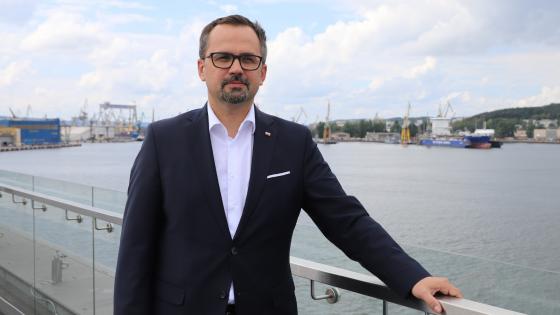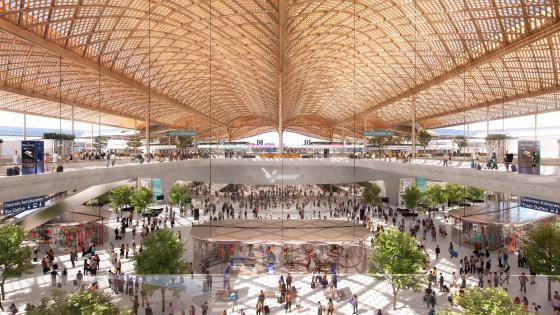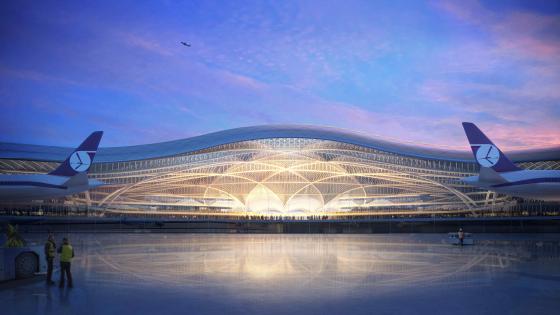Marcin Horała, Poland’s secretary of state and government plenipotentiary for the CPK, is responsible for the construction of the country’s newest transport hub. Tara Craig asked him about the project
Why is Centralny Port Komunikacyjny necessary?
The biggest airport in Warsaw – Chopin Airport – was already close to its maximum capacity before the COVID-19 pandemic, and its location, close to the city centre, meant that we could not develop it further. For the Polish aviation section to flourish, we needed a new plan that we could implement quickly. Centralny Port Komunikacyjny (CPK) is necessary for the Polish economy as a whole. The new airport will encourage investors to set up in Poland, in turn benefitting the entire region. The decision to develop CPK has been driven by data, not by emotions.
The idea is that CPK is not only an airport, but a key component of Poland’s transport system. We want travel times from all major cities in Poland to the new airport to be under 2hrs 30mins. This involves developing ten rail ‘spokes’ radiating from the hub, along with two additional lines serving cities previously without a rail connection

Marcin Horała is responsible for all air transport-related matters within Poland
Why not just invest more in the rail infrastructure?
By developing high-speed rail in Poland and Central and Eastern Europe (CEE) without the new airport, we would cut ourselves off from the potential value created by connecting the main transfer railway station with the main airport in one place. Full integration of the railway with the airport will make effective rail and air travel a reality. Our thinking is that the rail network will help power long-distance air connections because, for distances exceeding 800km, rail is no longer competitive.
How can the cost be justified?
The value of the whole CPK investment is estimated at €38bn, with the construction of the new airport accounting for €8bn and the railway investments for the remaining €30bn. The rationale for this investment is clear. While the global economy may be facing difficult times, Poland’s economy is forecast to grow. Despite a temporary slowdown, caused first by the pandemic and now by the war in Ukraine, CEE continues to offer significant investment opportunities.
According to current IATA forecasts, the new CPK airport will handle around 30 million passengers in its first full year of operation, and 40 million by 2035. More importantly, the construction of CPK will mean that travellers no longer need to transfer in other countries.

The airport will be part of a national transport system, with rail lines connecting it throughout Warsaw and beyond
Why are you persevering in the current political situation?
It is because the situation is so grave, especially in terms of the security of the region, that the project must be continued. The lesson from the war in Ukraine is that Poland needs a high-capacity airport, capable of 24/7 operations, suitable for cargo, and connected to the railway and road network. That’s why CPK has been planned as a ‘dual-use infrastructure’, a civil airport that can be used by NATO support and rapid response forces in the event of armed conflict.
What implications could the political and economic situations have?
Such large infrastructure projects will always be accompanied by risk, even in favourable political or economic times. That is why there is a department within the CPK set-up to anticipate and manage risk. We plan well in advance and take appropriate countermeasures. For example, CPK recently signed a preliminary agreement to purchase a controlling stake in Torpol, a company specialising in the modernisation and construction of railway infrastructure. The aim of this investment is to reduce the risk of having insufficient contractors.
How would you answer public comments on the project being rushed?
The idea of building a central airport dates back to the 1970s. Since 2000, analyses, reports and feasibility studies have been developed at government level. And the conclusion, as early as 2010, was that we needed to build a new transfer airport in the Warsaw catchment area.

CPK has been designed as a civilian airport that can also function as a military facility should the need arise
Tell us about the land earmarked for the airport
We are lucky to have – just 37km from central Warsaw – a vast area which can be planned properly. It is mostly agricultural and relatively sparsely inhabited. A Voluntary Acquisition Program (PDN) is underway, with more than 750 property owners signed-up to date. We are already performing appraisal reports, submitting offers, negotiating, signing memoranda of understanding, and concluding contracts for an area of almost 2,000ha.
What are the environmental implications of the project?
The site has been selected with environmental criteria in mind. Its impact on the ecosystem and biodiversity has been minimised. Within a radius of dozens of kilometres from the proposed airport there are no protected areas, and few forests.
CPK airport should also be viewed in the context of replacing the existing Chopin Airport. Being further from the city centre, the new airport will have a significantly smaller impact on neighbouring communities. For example, the number of people affected by excessive noise will be a tenth ofthose currently affected.
The unique combination of aviation and railway investments will enable us to reduce or fully eliminate the need for domestic flights and ensure that the majority of the connections to and from the airport will take place by rail, contributing to a modal shift from road transport (both passenger and freight), thus reducing green-house gas emissions.
Our vision is to deliver an airport that is well planned, properly designed, efficient for airlines and comfortable for passengers
Why did you choose so many international partners?
We have been signing contracts with many Polish (and Poland-based) companies. For instance, in December, we signed a framework contract with 13 companies and consortia, including many Polish businesses, for the design of the support facilities such as the air traffic control tower, and the airport operations centre.
Of course, in some industries related to the construction of a hub there are simply not enough competencies on the local market. This month we also signed a contract with the Spanish firm IDOM as airport systems integration designer (ASID). Its responsibilities will include the design, implementation, and integration of specialised airport systems.
In November we signed a contract with the Master Architect, British consortium Foster + Partners and Buro Happold. It will design the passenger terminal and railway station. This contractor has partners in the local market, for instance the Polish architect practice Kuryłowicz & Associates. A month earlier, we concluded another important contract: with Lebanese company Dar Al-Handasah, which will be our Master Civil Engineer, responsible for the design of the runways, taxiways, and aprons.

CPK has been designed as a civilian airport that can also function as a military facility should the need arise
What has been the greatest challenge for the project so far?
We are developing the largest infrastructure project in Europe today. We are building a new greenfield airport near the capital and 2,000km of new railway lines. I would say that the whole project is a great challenge, made up of smaller challenges, which – so far – we are managing perfectly.
Everything is on schedule. This year we will start building a 4km-long high-speed rail tunnel in Łódź and carry out preparatory building works on the airport site. The first stage of the airport should be open in 2028 and the rail elements of the project by the mid-2030s.
Our vision is to deliver an airport that is well planned, properly designed, efficient for airlines and comfortable for passengers. CPK Airport will be a world-class facility, with sustainability at its heart, that delivers value for money. By linking with neighbouring countries, CPK will help strengthen Poland’s connections with the largest economic centres in the CEE. That is why we are co-operating beyond borders with the likes of Rail Baltica.
